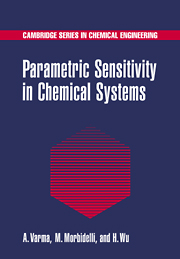Book contents
- Frontmatter
- Contents
- Preface
- 1 Introduction
- 2 Introduction to Sensitivity Analysis
- 3 Thermal Explosion in Batch Reactors
- 4 Runaway in Tubular Reactors
- 5 Parametric Sensitivity in Continuous-Flow Stirred Tank Reactors
- 6 Runaway in Fixed-Bed Catalytic Reactors
- 7 Parametric Sensitivity and Ignition Phenomena in Combustion Systems
- 8 Sensitivity Analysis in Mechanistic Study and Model Reduction
- 9 Sensitivity Analysis in Air Pollution
- 10 Sensitivity Analysis in Metabolic Processes
- Author Index
- Subject Index
7 - Parametric Sensitivity and Ignition Phenomena in Combustion Systems
Published online by Cambridge University Press: 04 May 2010
- Frontmatter
- Contents
- Preface
- 1 Introduction
- 2 Introduction to Sensitivity Analysis
- 3 Thermal Explosion in Batch Reactors
- 4 Runaway in Tubular Reactors
- 5 Parametric Sensitivity in Continuous-Flow Stirred Tank Reactors
- 6 Runaway in Fixed-Bed Catalytic Reactors
- 7 Parametric Sensitivity and Ignition Phenomena in Combustion Systems
- 8 Sensitivity Analysis in Mechanistic Study and Model Reduction
- 9 Sensitivity Analysis in Air Pollution
- 10 Sensitivity Analysis in Metabolic Processes
- Author Index
- Subject Index
Summary
Combustion processes are of central importance in a variety of applications, such as engines, turbines, and furnaces. The ignition of a combustion process can be either endogenous (i.e., self-ignition) or exogenous (i.e., induced by an external agent such as a spark or a local temperature increase). The identification of the self-ignition conditions for a given chemical system is not only of practical interest, but it is also a challenging test for the validation of combustion kinetic models. The first fundamental question that we address in this chapter is the definition of a criterion to establish whether a system has been ignited or not. As we will see in the following, this can be done by using the concepts related to parametric sensitivity discussed in previous chapters in the context of chemical reactors. As a model system we will use hydrogen oxidation, since it constitutes a prototype for more complex combustion processes, and its kinetic behavior has been well studied both experimentally and theoretically.
Ignition can be considered as a transition region or a boundary that separates slow from fast combustion processes. For combustion occurring in a shock tube or in a closed vessel, it is often required to determine the so-called ignition limits in a parameter space (typically temperature, pressure, and composition) that identify where the system is ignited, i.e., it undergoes a fast combustion process. For combustion induced by an external ignition source, a threshold needs to be defined to estimate the minimum energy required to ignite the system.
- Type
- Chapter
- Information
- Parametric Sensitivity in Chemical Systems , pp. 220 - 246Publisher: Cambridge University PressPrint publication year: 1999



